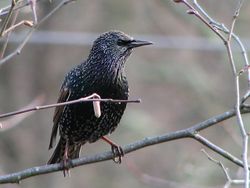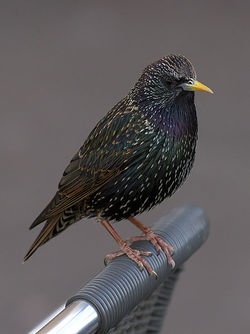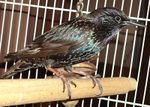European starling
| European starling |
|---|

|
| Scientific Classification |
| Binomial Name |
|
Sturnus Vulgaris |
| We see the European Starling perching on a ledge |
The European Starling is a species of starling known by the scientific name Sturnus vulgaris. Originated in North America by Shakespeare enthusiasts in the early 1890s. European Starlings are great vocal mimics and known to mimic 20 other different species. Beside being beautiful, In the United States are known for being loud, destructive birds. They steal grain, destroy crops, and also a threat to the native birds by destroying their eggs, and kill nestling. Today, about 200 million European Starlings are ranged from Alaska to Mexico, and many consider the pests.[2]
Body Design
At first glance the European starling may look like a black bird with its yellow beak and black plumage. As you take a closer look we see it is not, but is actually the European staring. As a young birds they all are pale brown until they grow their adult feathers and their bills are have a brownish- black color all year.[3] The European starting grows to the length of 8.5 inches weighting from 2.5 to about 3.5 ounces.[4] They begin to fly around 18-21 days of age. As an adult they poses a beautiful plumage, having an iridescent purple-ish black on its head and chest. The wings have a hue whereas the ending is brownish black.
They contain spot around their bodies although during the spring and winter the male tends to lose spots on its breast also its bill becoming blushing toward the base. Their legs are to have a pinkish reddish color. In the winter, new feather tips are a whitish color, giving this bird a more speckled appearance and their bills become a dark brown in both sexes. [5]
Life Cycle
Starlings are secondary cavity nesters. They do not excavate their own cavities, they take over other birds' nests. The procedure of mating starts with male starling securing a nest, then a female starling chooses a male starting to mate. Depending on a starling, residential starling begins to look for a nesting site in winter, and migratory starlings begin to look for a nesting in late winter to early spring. [6]
Female starling lays between 3 to 6 eggs. Incubation time is about 12 days. When hatchlings are hatched, they are naked. Fledging takes 21 to 23 days.[7]
Starligns comsume a variety of foods, including fruits adn seeds. Majority of their diet comes from insects. Coleoptera and lepidoptera lawn grubs total about one half of their diet. Another source of their diet comes from livestock rations and food in garbage during winter seasons.[8]
Ecology
The habitat of the European Starling are usually towns, suburbs, and the countryside near human settlements and live in flocks. Its diet is insects ,lizards ,frogs and other invertebrates, as well as Russian olives and other fruits. Probes into ground by spreading soil with bill, and mimics other species while feeding. They were released in New York in 1890 and had spread across the United States and Southern Canada. They are bold, aggressive, and are very territorial. [9] Starlings will also mob predators in flight, gathering into tight flocks and dive-bombing a hawk or other predators. Starlings are intelligent, they are adaptable, and are capable mimics. When there foraging they are generally walking or run along the ground probing the soil with beaks looking for food.[10]
Outside breeding season starlings usually join Blackbird flocks and they feed and roost together in small woodlots or overcrowded tree groves. If they are not feeding they may perch together in small groups on buildings or power lines. They may fly 15 to 30 miles per day from one plce to another to feed. During the winter there could be about 1 million birds in a flock but are confined to a few acres. They roost in urban tree landscapes and woodlands. [11] When a pair of starlings find a good nest they will evict the birds who inhabit the nest and destroy the eggs from the previous birds. If they can't find a nest to take over they will construct one with straw, grass, and with other materials. [12] Many saw the starlings as a big problem but people started eating them making them a delicacy. But they were decried as loud, obnoxious, destructive birds, who steal grain, ravage crops and crowd out native bird species. Many of the problems created by starlings stem from their abundance. Flocks can number in the thousands, and when a flock of this size settles on a field the damage they do is considerable. [13]
Invasive Species
Location and Method of Introduction The European starling brought to North America in 1890 by Shakespeare enthusiast, 100 were released into Central Park not knowing they would survive through the cold, rough winters. With the release, European Starlings are now scattered all among the continents. [14]
Environmental Impact
Far from being considered beautiful, delicious or beneficial, European Starlings in the United States are normally decried as loud, obnoxious, destructive birds, who steal grain, ravage crops and crowd out native bird species. The starlings have been attacking other bird species and stealing their nests. The estimated number of starlings that are in flocks are in the thousands but the starlings sometimes join black bird flocks. They also became a problem for livestock and poultry facilities congregating at feed troughs to eat, and contaminating food and water sources in the process.Cite error: Invalid <ref> tag; invalid names, e.g. too many
Control Methods There are many ways to control European Starlings. Exclusion, frightening, toxicants, and shooting. Nylon or plastic netting around the tree will prevent starlings from nesting on the tree. Frightening is effective in dispersing starlings from crops and livestock feeds. Chemicals such as starlicides are designed to have effects on just starlings and are harmless to ther birds and livestocks. Lastly, shooting is used to disperse starlings rather than killing them.[15]
Video
Starlings in formation.
References
- ↑ Sturnus vulgaris Wikispecies, Web. last modified on 16 November 2015
- ↑ All about Birds(https://www.allaboutbirds.org/guide/European_Starling/lifehistory) Unknown Author. Web. December 1 , 2015. Last accessed December 3, 2015.
- ↑ Unknown Author. (http://naturemappingfoundation.org/natmap/facts/european_starling_712.html) Nature Mapping Program. Web. November 16, 2015.
- ↑ James Chow. (http://www.biokids.umich.edu/critters/Sturnus_vulgaris/) BioKids. Web. November 16, 2015.
- ↑ (http://www.arkive.org/european-starling/sturnus-vulgaris/) WildscreenArchive. Unknown Author.Web. Month Day, Year. November 16, 2015
- ↑ All about starling(http://www.sialis.org/guide/European_Starling/lifehistory)Unknown Author . Web. November 19, 2015.
- ↑ European staling (http://mdc.mo.gov/discover-nature/field-guide/european-starling) . Web. December 14, 2015.
- ↑ European starling and their control Web. December 14, 2015. Unknown Author .
- ↑ Karl, Jason. Sturnus vulgaris (European starling)(http://imnh.isu.edu/digitalatlas/bio/birds/sngbrd/starlng/eust_mai.htm) http://imnh.isu.edu. Web. November 19, 2015. last accessed November 16, 2015.
- ↑ European Starling (http://birdweb.org/birdweb/bird/european_starling) http://www.birdweb.org/ Unknown Author . Web. November 19, 2015.
- ↑ European Starlings and Their Control (http://icwdm.org/handbook/birds/EuropeanStarlings.asp) http://icwdm.org/ Unknown Author. Web. November 19, 2015.
- ↑ McGarrity, Monica. Florida's Introduced Birds: European Starling (http://edis.ifas.ufl.edu/uw300)ufl.edu. Web. November 19, 2015.
- ↑ Adeney, Jennifer. Introduced Species Summary Project(http://www.columbia.edu/itc/cerc/danoff-burg/invasion_bio/inv_spp_summ/Sturnus_vulgaris.html) columbia.edu. Web. November 19, 2015.
- ↑ All about Birds(https://www.allaboutbirds.org/guide/European_Starling/lifehistory) Unknown Author. Web. December 1 , 2015. Last accessed December 2, 2015.
- ↑ European starling and their control(http://icwdm.org/handbook/birds/EuropeanStarlings.asp) Unknown Author. Web. December 14 , 2015. Last accessed December 2, 2015.



